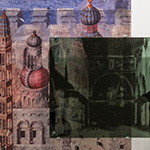A Cosmogram of Holy Views confronts the dissonance between the Holy Land as a mythical place in the western imaginary and the sacred architectures and geography of Palestine on the ground. “The Holy Land” is both revered in abstraction and obliterated in practice. Churches, relics, and imagined landscapes of Palestine are venerated, looted, and copied while the living communities and architectures that hold them are systematically displaced and destroyed by the same agents that revere them from a distance.
The exhibition unfolds a triptych across three spaces: the body, the spirit, and the land. Each installation reclaims fragments of personal and collective histories – material, architectural, and emotional – through transformed sculptures, reconstructions, and rituals. Wax relics of dismembered body parts become votive offerings , stone carved church windows with colored glass inlays as portals to the world of the martyrs, mother of pearl shrines for our artefacts, and an architectural model of my grandparents’ house as a sacred site, and glass and stone sculptures combine the spiritual and material makeup of the land. Finally, glass collages contrast personal archives and sacred moments in Palestine with western illustrations of the holy land.
Together, these works form a cosmogram: a re-presentation and reorientation of what “Holy”means to Palestinians today: where the sacred is not abstracted from land, body, and history, but embedded within them.
Press release from Ab-Anbar
Image: Dima Srouji. Sacred Dissonance 6. 2025. Screen prints and mixed media on glass. 88 x 69 cm. Image courtesy of the artist and Ab-Anbar Gallery



